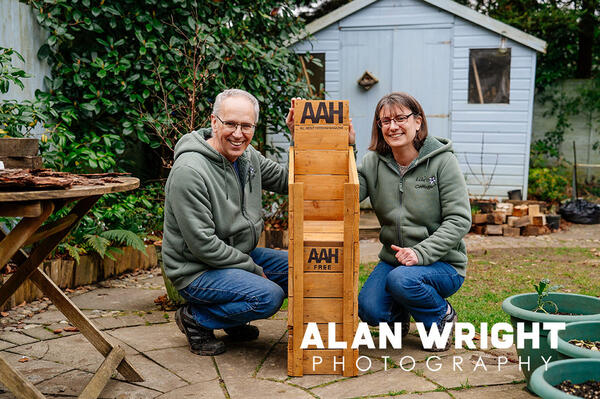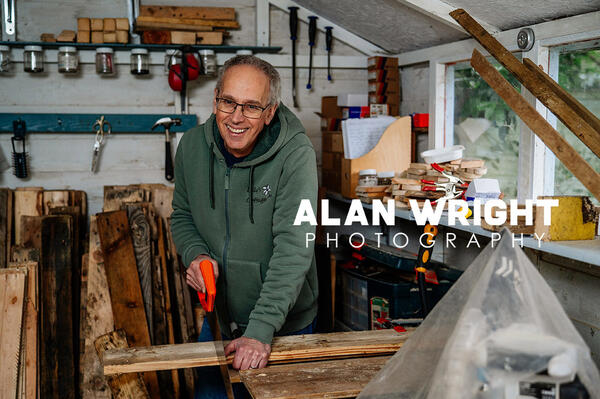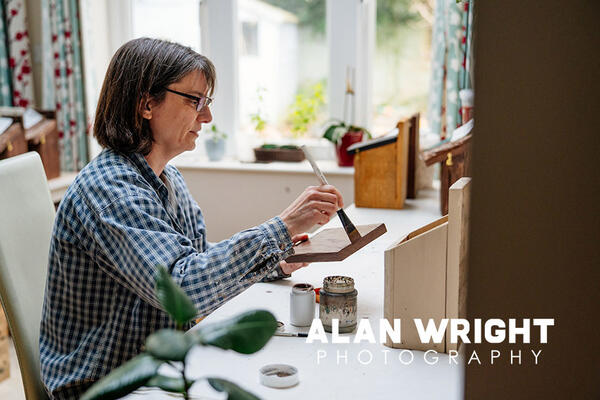LILY'S COTTAGE UPCYCLING

Published on 1st March 2025
When AAH needed a wooden display stand to match the décor and sustainable ethos of a local farm shop, they approached Lily’s Cottage. The husband-and-wife team of Martin and Debbie Standen built one from used pallets, adopting skills they’ve learned by making products for wildlife. We visited the couple at their Storrington home to find out more…
When was Lily’s Cottage formed?
Debbie: We launched Lily’s Cottage at the end of 2019, just before the pandemic. We already ran a well-established leafleting distribution business, M&D Services, but I was suffering from dizzy spells that left me struggling to perform admin tasks. Gradually, my symptoms worsened, to the point that I couldn’t watch TV or read a book. I was diagnosed with chronic vestibular migraine (CVM) and while medication has stabilised my condition, it still impacts my balance. I find computer work hard and can’t deliver either, as I’m unable to drive, due to my condition. So, while Martin has continued with M&D Services, we started thinking about a second business that I could be more involved with.
Why build wildlife habitats?
Martin: Our granddaughter stayed with us one weekend and we were thinking of ways to keep her entertained. We had a spare pallet from a leaflet delivery, so decided to make a bug house. Our granddaughter had a lovely time painting it, and we erected it in the garden. Family and friends loved it, as it had a solid, sturdy design. So, we made some for them too and the idea snowballed. We named the business after our King Charles spaniel, Lily, who has always been by our side, whether we’re building products at home or selling them at a local market.
Why do you use old pallets?
Martin: We collect them from a local garden centre and other sources (including AAH) and by re-using them, we’re given the wood another life. We researched bird and bug boxes already on the market and discovered that some are poorly-built imports made with flimsy plywood that soon rots or falls apart. Many include glue, which we don’t use as it’s not good for wildlife. Pallet wood is a better material for strength and insulation, but it’s important to use clean wood, as imported painted pallets can contain dangerous toxins.

How much research goes into products?
Debs: We follow the recommendations of organisations such as the RSPB and the Bat Conservation Trust. Everything we make is focused on wildlife, so there’s a feel-good factor behind the business. Our bird boxes encourage different species and you need to consider components carefully. You need to ensure the internal area is big enough for nesting, that the entrance is the right distance from the base for the birds you want to attract, and that the hole is small enough to deter larger birds and predators. We have seen wooden habitats offered elsewhere that look lovely but give little consideration to animal welfare, with poorly positioned entrances that increase the likelihood of chicks falling out, or making them an easy target for predators.
What are the other products you make?
Martin: We make homes for birds, bats, bees, bugs and hedgehogs and also larger items including owl boxes, compost bins, trough planters, pollination stations and Hedgehog Highway wildlife signs. A bat box requires a different design to bird boxes, as bats use a landing platform and slide into a horizontal slit underneath the box to build their nest. We have adapted our hedgehog box following advice from Hurst Hedgehog Haven, as our original design was a good feeding station, but not enough space for nesting.
What are your best-sellers?
Martin: Our standard bug house initially account for 50% of sales. However, its popularity has eased off as the bug house is a gateway product for schools and organisations. Children enjoy making bug houses in class or at Cubs and Brownies, and it encourages them to then try building other habitats. Bug houses are effective though, as they are really feeding stations that attract birds and begin life cycles. We have recently started building habitats for owls too. A customer asked us to build a box for a barn owl nesting near his home, in a dying tree that was due to be felled. He wanted to keep the owl in the area and searched online for an owl box, but those he found were expensive and included plastic components. So, he asked us to make one and we came up with a new design. The customer has since sent us incredible footage of a barn owl landing on the exercise platform at the front of the box and peering inside. Moments like that make our job worthwhile.

You also forage for natural materials?
Debs: We love walking on Sullington Warren, combing the ground for sticks and pine cones to fill pollination stations and bug boxes. We seek out sticks with nobbles and bends, as they tend to lock together when packed in tightly, creating nooks and crannies that bugs need to bed into. We top some of the bird boxes with bark foraged from woodland too and aesthetically it makes a difference. However, bark is an organic product, so it wears more than pallet wood.
How do you decorate habitats?
Debs: I sand the wood to remove rough edges and create a smooth surface to paint on. We use water-based paint and never paint the inside of a habitat where animals nest. Sometimes we add writing too, on items such as our Hedgehog Highway signs. We also make wooden jar feeders for birds, using our own bird mixture to fill recycled jars. We used to buy our bird food but found that it included fat, which drips and attract rodents. So, we created our own mix and people come to our market stall regularly to refill their jars.
Where do you sell your products?
Martin: During Covid, we sold on Etsy until craft fairs could re-open. We regularly have a stall at Billingshurst Artisan Market and occasionally attend markets in Steyning and the Carfax. We also attract lots of interest at events such as the CPRE Countryside Day at Knepp and Floral Fringe at Loxwood, as they tend to attract people with an interest in nature.
What are your hopes for the future?
Martin: We are now receiving commissions for certain things, such as habitats targeting a specific bird, and love the challenges these present. I still suffer from imposter syndrome, as I’m always amazed when someone buys things we’ve made from old pallets in our shed! However, it makes sense when you see some of the poor products sold elsewhere. Sometimes, people photograph our products with the idea of building something similar. It surprises people that we don’t mind too much, as nature will benefit. We’ve inherited our knowledge from others and are happy sharing what we know, if it means encouraging wildlife.
WORDS: BEN MORRIS
PHOTOS: ALAN WRIGHT FOR AAH
Further information:
Visit the website at: www.lilyscottageupcycling.square.site


